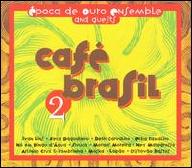A regional (small radio ensemble, typical of the choro and samba genres) organized by Jacob do Bandolim in 1961 in Rio de Janeiro (under several different names), the group was composed of Dino Sete Cordas on seven-string violão (acoustic guitar), César Faria (the father of Paulinho da Viola, who accompanied do Bandolim since 1939) and Carlinhos (Carlos Fernando de Carvalho Leite, born in 1924, Rio de Janeiro) on violões, Jonas (Jonas Pereira da Silva, born in 1934, Rio de Janeiro/died in 1997, Niterói) on cavaquinho, Gilberto d'Ávila (born in 1915, Rio de Janeiro) on pandeiro, and Jorginho (Jorge José da Silva, born in 1930, Rio de Janeiro) on rhythm. During the early 1961 and 1962 recordings, they were known as Jacob e Seus Chorões, including the special participation of bassist Luiz Marinho and percussionists like Barão and Pedro dos Santos. They recorded several albums for the RCA Victor label, beginning with Chorinhos e Chorões. In 1968, they participated in the historic show at the Teatro João Caetano, together with Jacob do Bandolim, Elizeth Cardoso, and the Zimbo Trio, which was recorded live and released by the Image and Sound Museum of Rio de Janeiro in two LPs. The LP Época de Ouro: Jacob do Bandolim also had the participation of an orchestra. Recorded in 1969, the year of Jacob do Bandolim's demise, it was the last album by the Época de Ouro during that period. The group dissolved, only to be reassembled in 1973 by César Faria, with Damásio (Damásio Batista de Sousa Filho, born in 1932, Rio de Janeiro/died in 1993) replacing Carlinhos and Déo Rian substituting do Bandolim. The group reopened by accompanying Paulinho da Viola that year, recording the LP Conjunto Época de Ouro the next year for Continental, followed by Clube do Choro: Conjunto Época de Ouro for the same recording company in 1976. In that decade, the group was very active, performing live in theaters and on TV shows. In 1992, they recorded Violões. Jonas left the group in 1985, and in 1997 the formation consisted of César Farias, Dino Sete Cordas, Toni (violão), Jorginho (pandeiro), Jorge (cavaquinho), and Ronaldo do Bandolim (mandolin). ~ Alvaro Neder, Rovi
Época de Ouro
Biography
After spending the '50s recording accompanied by an orchestra and the Regional do Canhoto, Jacob do Bandolim entered the '60s looking for an accompaniment formula more suited to his personal taste. The Época de Ouro were his solution.
Top Tracks
Albums
Videos
Close













